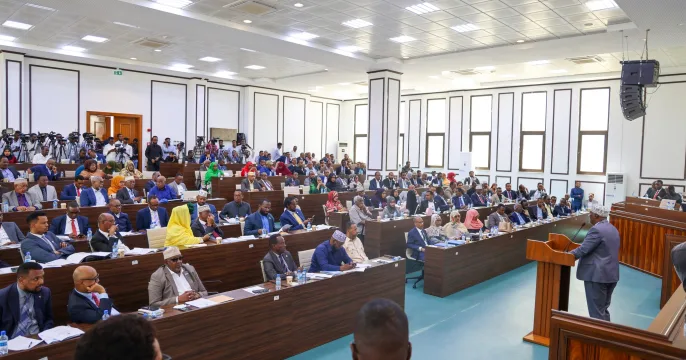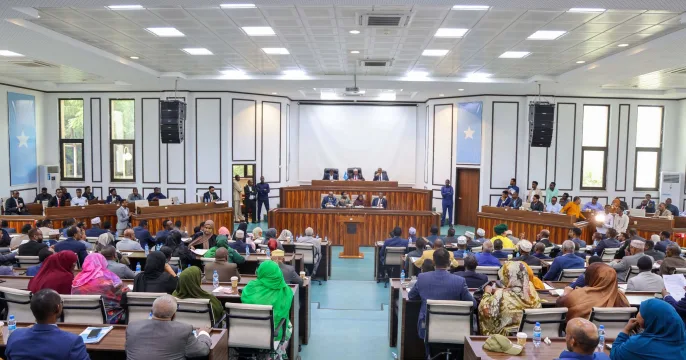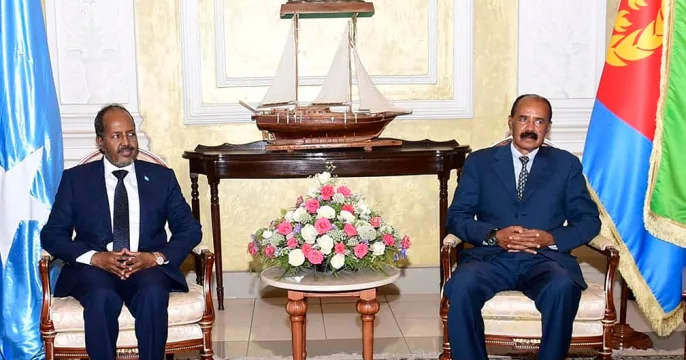by Peter Middlebrook, Dawit Ayele, Amba Tadaa and Eleni Armelinda Kubolli The last two decades has…

by Peter Middlebrook, Dawit Ayele, Amba Tadaa and Eleni Armelinda Kubolli
The last two decades has been a transformative period for Ethiopia. In the hands of the Ethiopian People’s Revolutionary Democratic Front (EPRDF), with Tigray People’s Liberation Front (TPLF) at its core, the nation embarked on a robust growth trajectory. This was marked by a state-led development model, underpinned significantly by external financing, notably debt from China, alongside grants from international cooperation partners. Yet, despite this remarkable economic expansion, the benefits accrued in this period were not fairly distributed, contributing to many internal challenges within the EPRDF-led government. These tensions culminated in a major political shift, as the legacy of Meles Zenawi’s leadership slowly ebbed away – effectively reducing the TPLF’s dominant role and paving the way for Abiy Ahmed’s rise to power in 2018. The collapse of EPRDF and rebalancing of center-periphery relations among other factors, led to the civil war, between November 2020 and November 2022.
Parallel to the conflict, the years since 2020 were also marked by COVID-19, ongoing climate stresses, global capital tightening, and inflationary pressures (particularly among food and other staple goods), leading to a dire macro-fiscal situation. Economic headwinds and challenges in servicing debt have forced Ethiopia’s hand resulting in Abiy’s commitment to long overdue structural reforms, notably in a pivot away from a state-led economy towards a more liberal economic order. Government has moved to liberalize telecoms, banking and logistics, moving to establish domestic capital markets and deepen financial markets, while also spearheading the much-needed restructuring of state-owned enterprises towards corporatization and privatization. Though economic headwinds remain, particularly in relation to foreign currency, debt servicing and revenue mobilization, the effects of liberalizing reforms will fundamentally rebalance the relationship between public and private capital; the state and the market.
One the legacies of Ethiopia being two decades behind most countries who liberalized following the collapse of the Soviet Union is that financing structure for the country is wrong. With a burgeoning population pressure, the focus on short term loans, lack of proper financing for the national development program and many projects being poorly executed, Ethiopia must finally seize the moment to modernize both state apparatus and enable market reforms to bridge the huge gap between demand and supply. Moreover, as Ethiopia became addicted to global borrowing and grants – both of which have now stopped – and with the rates of return on infrastructure investment unable to service the debt used for construction – debt sustainability challenges have begun to emerge. There is also huge internal domestic demand for capital, yet liquidity issues remain and the cost of finance undermines growth outcomes.
As a result, 2024 represents a ‘Back to the Future’ moment for Ethiopia, in which the country’s Homegrown Economic Reform Agenda (HGER II) is to be launched, a reform agenda which addressed key macroeconomic vulnerabilities and hopes to unleash Ethiopia’s considerable economic potential. With the post-COVID-19 global economy already accelerating investments towards developing green, frictionless, paperless, automated, and virtual economies, Ethiopia has the unique opportunity not just to bounce back, but also to bounce forward; potentially avoiding the pitfalls experienced by many other nations. But what – we ask – will it take to build a future-ready economy from the spoils of a model of state capitalism sprinkled with cronyism!
Challenges of Liberalizing the Economy After 30 Years of State Capitalism
Transitioning from three decades of state capitalism to a liberalized economy presents Ethiopia with profound challenges. The state has long been the primary driver of economic activity, with large state-owned enterprises (SOEs) dominating sectors from telecommunications to banking. This systemic shift requires not just policy revisions but a complete overhaul in mindset. Urgent priorities include, but are not limited to:
- Implementing foreign exchange (FOREX) reforms to transition to a unified market exchange rate while addressing capacity constraints related to the foreign exchange market.
- Restructuring debt – and moving towards a debt financing model that can be serviced through growth – to manage and reduce the future debt burden.
- Undertaking financial sector reforms, particularly addressing non-performing debts of state-owned enterprises (SOEs).
- Developing a future ready Medium-Term Revenue Strategy (MTRS) that emphasizes the importance of tax as instrument for promoting economic growth, with a priority commitment towards a fully automated digital tax collection system.
- Balanced financial sector liberalization and regulation to encourage domestic capital market development, closing the ‘missing middle’ in retail and SME financing.
- Enhancing efforts to increase exports, in a bid to diversify the economy.
- Establishing order and the pursuit of a strong peace agenda throughout Ethiopia’s many regions.
- Fundamentally restructuring government services and the digital economy towards a future-ready automated and inclusive system of social and economic governance.
- Embracing and integrating new sustainable financing instruments into core sectors.
Learning lessons from history, the transition from state capitalism to market-based systems in former Eastern Europe highlights the significant challenges involved in this process. Many Balkan states (including North Macedonia, Bosnia and Herzegovina and Albania) have still not acceded to the European Union (EU), despite a quarter of a century of efforts to embrace the new-liberal governance order.
In a similar vein, Ethiopia will face significant hurdles. These include the need to establish functioning market mechanisms and regulatory frameworks, shifting from central planning to market-oriented policies. Privatization of state-owned enterprises often led to social and economic disruptions, such as increased unemployment and inequality. Additionally, the development of a competitive private sector was hindered by inadequate legal systems, lack of entrepreneurship experience, and limited access to capital. The transition also required substantial changes in governmental roles and policies, which were often met with resistance, further complicating the process. These lessons ring-out for Ethiopia, given relatively limited installed capacities to implement what must be seen as one of the last liberalizing reform agendas of the post-Soviet legacy.
Given that Ethiopia’s population is projected to reach 350 million by the end of the 21st Century, fundamental changes to agriculture, production and urbanization are a must, as is a focus on inclusive growth. If growth fails to be inclusive, when combined with climate change, existing internal tensions, rural-to-urban migration, internal displacement and outflows to the Gulf States and beyond seems almost inevitable. Future proofing the economy to thwart such an eventuality must start now and remain a priority.
Embracing Historical Reform Economic Opportunities
Despite these challenges – made worse by lack of installed capacity to nimbly address the long list of urgent reforms – it is important to remember that Ethiopia was the poster child for African economic reforms for over two decades despite embracing a backward-looking economic ideology. Ethiopia must now pivot to the future, embracing a broad set of modernizing reforms that will carry its growing population forward at pace. Assuming that capacities to accelerate reforms can be installed – with considerable international community support – the following five high level priorities would appear to be key to securing Ethiopia’s future and evolution towards a middle-income economy:
- Mindset Change Leaning into the Resilience Agenda and a New Financing Architecture: Modernizing and future-ready reforms start with mindset change. Without a deeply engrained new way of thinking, impetus will fall behind future pressures and reforms will fall short. Some shock therapy is probably required to jolt Ethiopia into such a future reform trajectory, with 2024 likely to provide that moment. Moving away from ‘government’ to embracing ‘governance’, mindset change will need to be deeply invested in long-term, sustainable, and inclusive growth across various strategic areas like digitalization, climate, food, supply chains, technology, organization, education, and healthcare.
- Deep Digital Transformation through Digital-By-Default Policies: In the future, all revenues will need to be collected digitally and online transactions taxed. Digital IDs and automated services are the future for Ethiopia, creating frictionless delivery systems and services. Instead of investing in costly ICT infrastructure, star-link based delivery systems can allow Ethiopia to save tens of billions of dollars in investment that would then be obsolete. Following the SMART city approach to automated digital services as followed by the UAE and Azerbaijan are the way to travel, with private capital crowded into to drive the digital, FINTECH, frictionless, cashless, mobile-based, and circular economic future that will need to emerge through a private-sector first approach.
- Unleashing the Potential of the Diaspore and Youth: Ethiopia stands on the brink of harnessing a significant demographic dividend, a potential economic boost driven by a large and youthful population. As a substantial portion of its population enters the workforce, Ethiopia could experience accelerated economic growth if these young people are equipped with education, health services, and entrepreneurial opportunities. At the same time the reverse is true, and the failure to invest in the next generation would set Ethiopia back by many decades. Capitalizing on this demographic advantage will require strategic investments in human capital and job creation, while engaging the brilliant Ethiopian Diaspora to be part of the technology innovation transition process.
- Planning Widescale Scalable SMART Cities with Affordable Solutions: Urbanization is currently both unstoppable but unsustainable. Ethiopia must embrace a vision for future urban development hinged on the creation of scalable SMART cities, focusing on sustainability, affordability, innovation, digital connectivity and inclusivity. Power, water, education, health, innovation hubs and circular municipal economies can be conceptualized, and private capital incentivized towards their construction. Here, government fiscal policy will need to be as much about shaping economic incentives as funding the public purse.
- Deepening Financial and Capital Markets: As the old saying goes, talk is cheap but money buys whiskey. Unless there is a very rapid deepening of both financial and capital markets, Ethiopia risks being starved of working capital to drive this revolution. As smartphones emerge as the personal banks and service hubs of the future, the entry of foreign banks and FINTECH companies into the economy is already late. Capital markets will take years to emerge, but they will, and this will be critical to growing a society and economy that is resilient to both external shocks and their domestic amplifiers.
- Consolidating Peace and Political Settlements: Fundamental to Ethiopia’s transformative agenda is the consolidation of peace and stability, a precondition for sustainable development and investment attraction. The government’s role in settling conflicts and disputes within the country is paramount. Engaging in constructive dialogue and reaching political settlements are crucial to achieving a harmonious and cohesive society. This process should involve building institutions of the future, efficient in providing services, and streamlining governance and law enforcement.
Securing Ethiopia’s Future and Stabilizing the Horn of Africa
Ethiopia’s trajectory towards becoming a middle-income country by 2050 is not just a national ambition but a regional necessity. Its economic stabilization and growth are critical for the Horn of Africa’s peace and development. While calls to reclaim the coastline it lost in 1991 are growing louder, creating a trading hub through Asab Port might kill Djibouti. For Egypt, the stability of all riparian states is vital and Ethiopia now sits as the fountainhead for the entire region. Regional connectivity and integration – strong alliance with the Gulf States and emerging trading nations – will be key to establishing a vibrant regional market that is not lost to ethnicity or patrimonial interests.
Conclusion
Ethiopia may be too big to fail – but size alone does not guarantee victory. Ethiopia’s journey towards building a future-ready economy may be fraught with challenges but it is also filled with immense potential. The transformation from a state-driven economic model to a more liberalized and inclusive one is central to this journey. At the same time a new financial architecture is required for the country, better balancing supply and demand and substantially lowering the cost of borrowing for sustainable development. The country’s rich history, strategic geopolitical location, and untapped economic opportunities place it in a unique position to not only secure its own future but also contribute significantly to the stability and prosperity of the Horn of Africa. By 2050, with the right policies, international support, and a continued focus on sustainable and inclusive growth, Ethiopia can emerge as a resilient middle-income country, setting a precedent for economic transformation in the region.
Peter Middlebrook is the CEO of Geopolicity Inc., and a former World Bank, EU and UK Government economist. Dawit Ayele is a Senior Advisor to the Ethiopian Government. Amba Tadaa is a Project Director at Geopolicity Inc., and Eleni Armelinda Kubolli is an intern with Geopolicity Inc. on European Development Policy.





